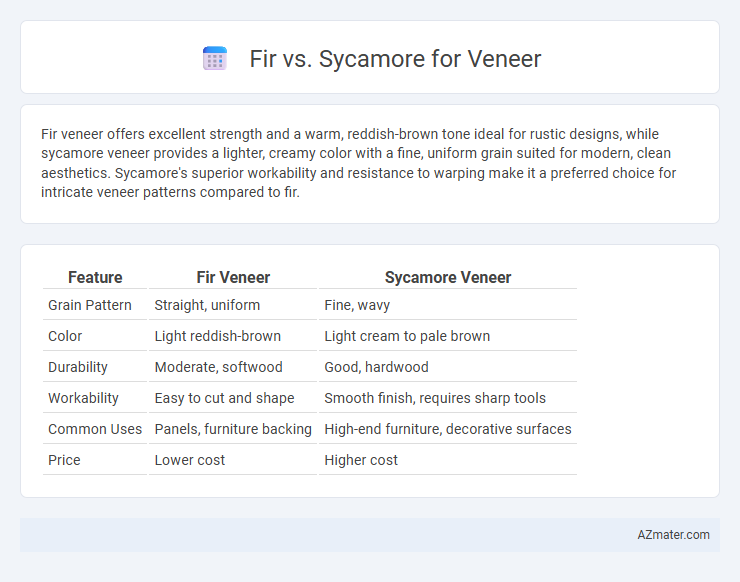Fir veneer offers excellent strength and a warm, reddish-brown tone ideal for rustic designs, while sycamore veneer provides a lighter, creamy color with a fine, uniform grain suited for modern, clean aesthetics. Sycamore's superior workability and resistance to warping make it a preferred choice for intricate veneer patterns compared to fir.
Table of Comparison
| Feature | Fir Veneer | Sycamore Veneer |
|---|---|---|
| Grain Pattern | Straight, uniform | Fine, wavy |
| Color | Light reddish-brown | Light cream to pale brown |
| Durability | Moderate, softwood | Good, hardwood |
| Workability | Easy to cut and shape | Smooth finish, requires sharp tools |
| Common Uses | Panels, furniture backing | High-end furniture, decorative surfaces |
| Price | Lower cost | Higher cost |
Introduction to Fir and Sycamore for Veneer
Fir veneer features a straight, uniform grain and light reddish-brown hue, making it popular for furniture and interior paneling due to its durability and ease of finishing. Sycamore veneer is prized for its fine, creamy texture and distinctive, wavy grain patterns, adding elegance and a smooth surface ideal for high-end cabinetry and decorative applications. Both woods offer unique aesthetic qualities and workability that cater to different design preferences and functional requirements in veneer production.
Botanical Differences: Fir vs Sycamore
Fir trees belong to the genus Abies within the Pinaceae family, characterized by needle-like leaves and cones that stand upright on branches, whereas Sycamore trees, primarily from the genus Platanus in the Platanaceae family, display broad, lobed leaves and large, spherical seed balls. Fir wood features a relatively uniform texture due to its softwood classification, while Sycamore is a hardwood with a more intricate grain pattern and greater density. The botanical differences between Fir and Sycamore directly influence their veneer applications, with Fir favored for its lightness and workability, and Sycamore prized for its decorative, figured grain.
Veneer Appearance: Grain Patterns and Color
Fir veneer exhibits straight, uniform grain with a warm, reddish-brown tone that adds a classic, rustic appeal to interiors. Sycamore veneer features more varied grain patterns, including subtle, wavy figures and a lighter, creamy color palette, creating a brighter and more dynamic aesthetic. The choice between fir and sycamore veneers impacts design style, with fir offering consistent texture and sycamore providing distinctive visual interest through its unique grain variations.
Durability and Strength Comparison
Fir veneer offers moderate durability and good strength, making it suitable for interior applications where a balance of workability and resilience is needed. Sycamore veneer exhibits higher hardness and density, providing superior strength and greater resistance to wear and impact, ideal for high-traffic areas or furniture requiring long-lasting performance. Both veneers can be finished well, but sycamore's natural toughness gives it an edge in durability compared to fir.
Workability and Machining Performance
Fir veneer offers excellent workability due to its straight grain and moderate hardness, allowing for smooth cutting and shaping without excessive wear on tools. Sycamore veneer, characterized by its fine, even texture and hardness, provides superior machining performance with clean edges and minimal splintering. Both veneers machine well, but Fir's softer nature makes it easier for intricate detailing, while Sycamore's hardness supports durability in high-precision applications.
Cost Analysis: Fir vs Sycamore Veneer
Fir veneer generally offers a lower cost option compared to Sycamore veneer due to its abundant availability and faster growth rate, reducing raw material expenses. Sycamore veneer commands a higher price, driven by its finer grain, aesthetic appeal, and slower growth, which impacts supply and processing costs. Choosing between Fir and Sycamore veneer hinges on balancing budget constraints with desired visual texture and durability characteristics.
Environmental Impact and Sustainability
Fir veneer is known for its rapid growth and abundant availability, making it a more sustainable option due to lower ecological strain and quicker replenishment rates. Sycamore veneer, while aesthetically appealing, grows more slowly and is less common, potentially leading to greater environmental impact through habitat disruption and slower forest recovery. Choosing fir supports sustainable forestry practices by favoring a species with higher carbon sequestration potential and reduced deforestation pressure.
Common Applications in Veneer Projects
Fir veneer is favored in commercial and residential applications for its strength and smooth grain, making it ideal for cabinetry, paneling, and furniture. Sycamore veneer, known for its distinctive mottled grain and light color, is commonly used in high-end millwork, decorative wall panels, and custom furniture to add visual interest. Both veneers provide durable surfaces, but Fir is preferred for structural uses while Sycamore enhances aesthetic appeal in veneer projects.
Maintenance and Longevity Considerations
Fir veneer offers moderate durability with a natural resistance to decay, requiring regular sealing and occasional refinishing to maintain its appearance and structural integrity. Sycamore veneer provides a harder surface that resists dents and scratches better than fir, demanding less frequent maintenance but benefiting from protective coatings to prevent moisture damage and prolong lifespan. Both veneers need appropriate care, but sycamore's superior hardness contributes to longer longevity under high-use conditions.
Choosing Between Fir and Sycamore Veneer
Fir veneer offers a warm, reddish-brown hue with a straight, pronounced grain pattern ideal for rustic and traditional designs. Sycamore veneer features a lighter, creamy color and a more subtle, interlocking grain that provides a smooth and refined appearance suitable for modern interiors. Choosing between fir and sycamore veneers depends on the desired aesthetic, durability needs, and the overall style of the furniture or paneling project.

Infographic: Fir vs Sycamore for Veneer
 azmater.com
azmater.com